 W
WAgnostida is an order of arthropod which first developed near the end of the Early Cambrian period and thrived during the Middle Cambrian. They are present in the Lower Cambrian fossil record along with trilobites from the Redlichiida, Corynexochida, and Ptychopariida orders. The last agnostids went extinct in the Late Ordovician.
 W
WAsaphida is a large, morphologically diverse order of trilobites found in marine strata dated from the Middle Cambrian until their extinction during the Silurian. Asaphida contains six superfamilies, but no suborders. Asaphids comprise some 20% of described fossil trilobites.
 W
WAsaphus expansus is the type species of the asaphid trilobite genus Asaphus. It was previously classified as Entomostracites expansus before being split off into its own genus.
 W
WAulacopleura is a genus of proetid trilobite that lived from the Middle Ordovician to the Middle Devonian. Some authors may classify this group as subgenus Otarion (Aulacopleura). The cephalon is semicircular or semielliptical, with border and preglabellar field. The glabella is short, with or without defined eye ridges connecting it with eyes of variable size. Spines at the rear outer corners of the cephalon are present, typically reaching back to the 2nd to 4th thorax segment. The 'palate' is not connected to the dorsal shield of the cephalon. The cephalon is pitted, or has small tubercles. The thorax has up to 22 segments. The pleural ends are usually rounded. The pygidium is small (micropygous), with an even margin. A. koninckii had a modern type of compound eye.
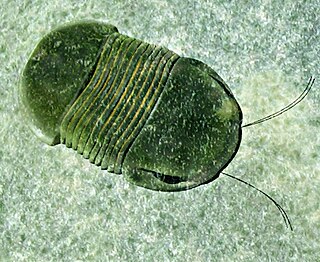 W
WBumastus is an extinct genus of corynexochid trilobites which existed from the Early Ordovician period to the Late Silurian period. They were relatively large trilobites, reaching a length of 6 in (15 cm). They were distinctive for their highly globular, smooth-surfaced exoskeleton. They possessed well-developed, large compound eyes and were believed to have dwelled in shallow-water sediments in life.
 W
WCheiruridae is a family of phacopid trilobites of the suborder Cheirurina. Its members, as with other members of the suborder, had distinctive pygidia modified into finger-like spines. They first appeared in the uppermost Cambrian, and persisted until the end of the Middle Devonian (Givetian). Currently about 657 species assigned to 99 genera are included.
 W
WCheirurina is a suborder of the trilobite order Phacopida. Known representatives range from the uppermost Cambrian to the end of the Middle Devonian (Givetian). Cheirurina is made up of a morphologically diverse group of related families.
 W
WCheirurus is a genus of phacopid trilobites that lived from the Late Cambrian to the Middle Devonian. Its remains have been found in Africa, Asia, Australia, Europe, and North America. Cheirurus is the type genus of Cheiruridae.
 W
WColpocoryphe is a genus of trilobites in the family Calymenidae.
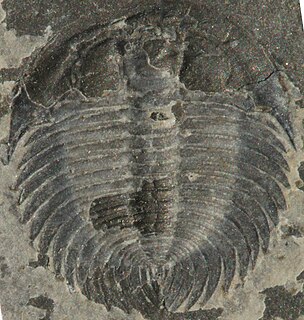 W
WCorynexochida is an order of trilobite that lived from the Lower Cambrian to the Late Devonian. Like many of the other trilobite orders, Corynexochida contains many species with widespread characteristics.
 W
WCyclopygidae is a family of asaphid trilobites from the Ordovician. Cyclopygids had an extratropical distribution, and there is evidence that they lived in darker parts of the water column. Cyclopygids are characterized by enlarged eyes, with a wide angle of view, both horizontal and vertical, reminiscent of the eyes of dragonflies. These typically touch the glabella directly on the side. Cyclopygids all lack genal spines, but Symphysops carries a forward directed frontal spine on the glabella. It is presumed that at least the members of the genus Pricyclopyge swam upside down and had bioluminescent organs on the third thorax segment. Cyclopygids had between 7 and 5 thorax segments, a wide and stout axis, and short side lobes.
 W
WCyphaspis is a genus of small trilobite that lived from the Late Ordovician to the Late Devonian. Fossils have been found in marine strata in what is now Europe, Africa and North America. Various species had a compact body, and a large, bulbous glabellum. Many species had long spines arranged similarly to closely related genera, such as Otarian, Otarionella, Chamaeleoaspis, and Namuropyge.
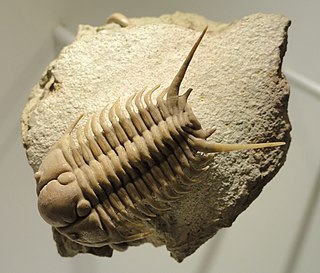 W
WCyrtometopus is an extinct genus of trilobite in the order Phacopida.
 W
WDalmanites is a genus of trilobite in the order Phacopida. They lived from the Late Ordovician to Middle Devonian.
 W
WDiacalymene is a genus of trilobite from the order Phacopida, suborder Calymenina. It includes the species D. ouzregui, D. clavicula, D. diademata and D. gabrielsi. It lived in the Ordovician and Silurian periods.
 W
WDindymene is an extinct genus of trilobites in the order Phacopida. It contains two species, D. didymograpti, and D. hughesiae.
 W
WDipleura is a genus of trilobites in the order Phacopida. It was described by Green in 1832, and the type species is Dipleura dekayi. The type locality was in the Hamilton Group in New York.
 W
WEctillaenus is a genus of trilobites in the order Corynexochida.
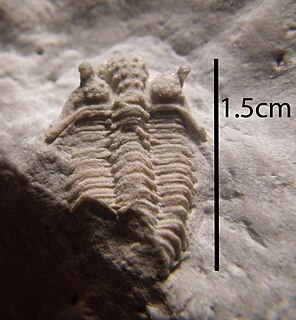 W
WEncrinuridae is a family of trilobite within the order Phacopida that lived in what would be Africa, Asia, Australia, Europe, North America, and South America from the middle Ordovician to the early Devonian from 479 to 412.3 million years ago, existing for approximately 66.7 million years .
 W
WEncrinurus is a long-lived genus of phacopid trilobites that lived in what are now Africa, Asia, Australia, Europe, North America, and South America from the middle Ordovician to the early Devonian from 472—412.3 mya, existing for approximately 59.7 million years .
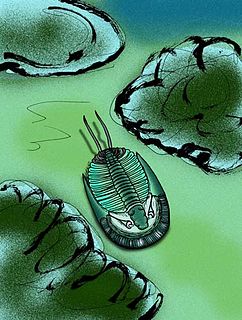 W
WEntomaspis is an extinct genus of harpetid trilobite from Upper Cambrian to Early Ordovician marine strata of the United States. Species are typified by their proportionally large, vaulted, croissant-shaped or bonnet-shaped cephalons that have the cheeks freed to become elongated, curved librigenial spines, and by their comparatively large, crescent-shaped eyes.
 W
WFlexicalymene is a genus of trilobites of the order Phacopida, suborder Calymenina. They are found abundantly in North America. Flexicalymene specimens can be mistaken for Calymene, Gravicalymene, Diacalymene and a few other Calymenina genera. They are used as an index fossil in the Ordovician. Ohio and North America are particularly known for being rich with Flexicalymene fossils. Species include F. meeki and F. retrorsa, F. granulosa, F. senaria and F. croneisi (Ontario).
 W
WFrencrinuroides is a genus of trilobites in the order Phacopida, that existed during the upper Ordovician in what is now the United States. It was described by Lesperance and Desbiens in 1995, and the type species is Frencrinuroides capitonis, which was originally described under the genus Encrinuroides by Frederickson in 1964. The type locality was the Bromide Formation in Oklahoma.
 W
WGabriceraurus is a trilobite in the order Phacopida, that existed during the upper Ordovician in what is now Canada. It was described by Pribyl and Vanek in 1985, and the type species is Gabriceraurus gabrielsi, which was originally described under the genus Ceraurus by Ludvigsen in 1979. The type locality was the Esbataottine Formation in the Northwest Territories.
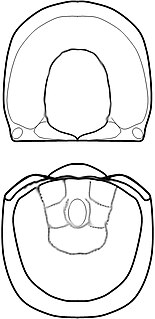 W
WGalbagnostus is an extinct genus of agnostid trilobite. It lived during the Lower and Middle Ordovician.
 W
WGeragnostus is a genus of very small agnostid trilobites whose fossils are found Ordovician-aged marine strata from Eurasia, North America and Argentina.
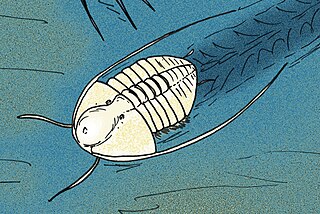 W
WGlobampyx is an extinct genus raphiophorid trilobites. It lived during the later part of the Arenig stage of the Ordovician Period, approximately 478 to 471 million years ago. Species of the genus are known from Canada, Norway (Svalbard) and Sweden.
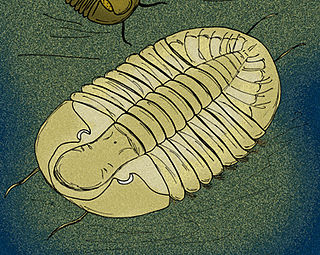 W
WGog is a genus of large, flattened asaphid trilobite from the Middle Arenig-aged Svalbard, Valhallfonna Formation, Olenidsletta, Member, of Spitzbergen, Norway, and the Upper Arenig-aged Dawan Formation in Hubei, China.
 W
WGog is a genus of large, flattened asaphid trilobite from the Middle Arenig-aged Svalbard, Valhallfonna Formation, Olenidsletta, Member, of Spitzbergen, Norway, and the Upper Arenig-aged Dawan Formation in Hubei, China.
 W
WGyrometopus is an extinct genus from a well-known class of fossil marine arthropods, the trilobites. It lived during the Arenig stage of the Ordovician Period, approximately 479 to 472 million years ago.
 W
WHan is a monotypic genus of agnostid trilobite, whose sole member is Han solo. The type specimen of H. solo was found in marine strata of the Arenig to Llanvirn-aged Zitai Formation of Middle Ordovician southern China, and is named after the character in Star Wars.
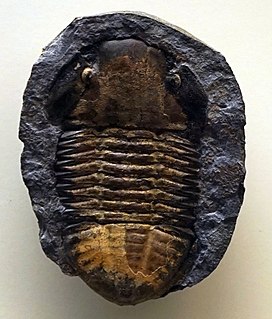 W
WHoekaspis is an extinct genus of trilobites from the family Asaphidae. It lived during the early part of the Arenig stage of the Ordovician, a faunal stage which lasted from approximately 466 to 461 million years ago.
 W
WHoplolichoides conicotuberculatus is a species of lichid trilobites belonging to the family Lichidae. These fast-moving low-level epifaunal carnivores lived in the Middle Ordovician of Russia.
 W
WThe Illaenidae are a family of trilobites in the order Corynexochida. 223 currently accepted species in 24 genera are known from the Ordovician. Some scholars include the Panderiidae in the Illaenidae, but this is not generally supported.
 W
WIllaenus is a genus of trilobites from Russia and Morocco, from the middle Ordovician.
 W
WIllaenus crassicauda is a species of trilobites belonging to the family Illaenidae. These trilobites lived in the middle Ordovician and in the Silurian age. Fossils of this species have been found in the sediments of Sweden and Russia.
 W
WIllaenus tauricornis is a species of trilobites from Russia and Morocco, from the middle Ordovician.
 W
WIsotelus is a genus of asaphid trilobites from the middle and upper Ordovician period, fairly common in the Northeastern United States, northwest Manitoba, southwestern Quebec and southeastern Ontario. One species, Isotelus rex, is currently the world's largest trilobite ever found as a complete fossil.
 W
WKanoshia is a genus of trilobites in the order Phacopida, that existed during the middle Ordovician in what is now Utah, USA. It was described by Harrington in 1957, and the type species is Kanoshia kanoshensis, which was originally described under the genus Pseudomera by Hintze in 1953. It also contains the species K. depressus and K. reticulata. The generic name is derived from the type species' epithet, which in turn is derived from the name of the type locality, the Kanosh Formation.
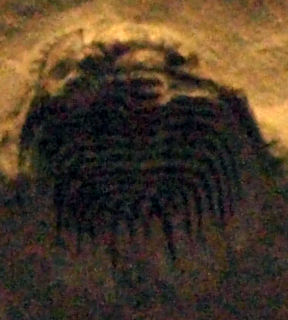 W
WLeonaspis is a widespread genus of odontopleurid trilobite that lived from the Late Ordovician to the late Middle Devonian. Fossils of various species have been found on all continents except Antarctica.
 W
WLichida is an order of typically spiny trilobite that lived from the Furongian to the Devonian period. These trilobites usually have 8–13 thoracic segments. Their exoskeletons often have a grainy texture or have wart or spine-like tubercles. Some species are extraordinarily spiny, having spiny thoracic segments that are as long or longer than the entire body, from cephalon (head) to pygidium (tail). The sections of the pygidia are leaf-like in shape and also typically end in spines.
 W
WLonchodomas is a genus of trilobites, that lived during the Ordovician. It was eyeless, like all raphiophorids, and had a long straight sword-like frontal spine, that gradually transforms into the relatively long glabella. Both the glabellar spine and the backward directed genal spines are subquadrate in section. Lonchodomas has five thorax segments and the pleural area of the pygidium has two narrow furrows. Lonchodomas occurred in what are today Argentina, Canada (Newfoundland), Estonia, Latvia, Norway, Sweden, the Russian Federation and the United States.
 W
WMegalaspides is an extinct genus from a well-known class of fossil marine arthropods, the trilobites. It lived during the later part of the Arenig stage of the Ordovician Period, approximately 478 to 471 million years ago.
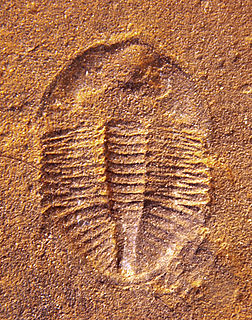 W
WOgygiocarella is a genus of asaphid trilobites. It occurred during the Middle Ordovician.
 W
WOnnia is a genus of trilobites from the late Ordovician of Africa, Europe, North America, and South America. Fossils have been found in Canada (Quebec), the Czech Republic, France, Morocco, Portugal, Spain, the United Kingdom, and Venezuela.
 W
WPanderia is a genus of trilobites in the order Corynexochida.
 W
WPanderiidae is a family of trilobites in the order Corynexochida.
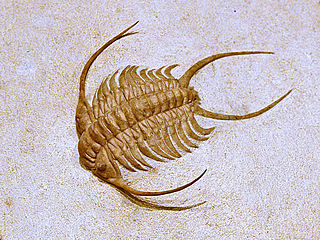 W
WParaceraurus exsul is a species of trilobite that lived in St. Petersburg Region and Tver Region of Russia, Estonia, Finland, Sweden, North Germany, Lithuania and Belarus during the Upper Llanvirnian Stage of the Middle Ordovician. These trilobites can reach a length of about 16 centimetres (6.3 in). They show a square front edge, large genal spines on the cheeks and characteristic long pygidial spines. Genal spines are curved usually inward and upward.
 W
WPliomera is a genus of trilobites that lived during the Middle Ordovician on the paleocontinent Baltica, now Norway, Sweden, Estonia and the Russian Federation, and in Argentina. It can be recognized for its pentagonal glabella widest between the frontal corners, with an inverted V-shaped occipital ring. In front of the occipital furrow that crosses the entire glabella, two pairs of dead-ending furrows create three side lobes left and right. The front of the glabella also has three dead-ending furrows, a very short one on the midline and left and right a longer one, directed inward and slightly backward. The eyes are small and are not connected to the glabella by an eye ridge. The thorax and pygidium are very regularly divided into up to 23 rather narrow segments, without a furrow within each of the pleurae. The pleurae are clearly wider than the axis. The pygidium ends in downward pointing toothlike spines.
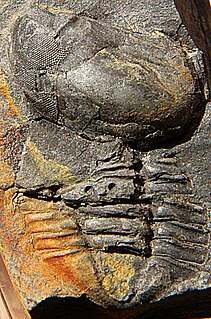 W
WPricyclopyge is a genus of trilobites assigned to the family Cyclopygidae that occurs throughout the Ordovician. Pricyclopyge had an extratropical distribution, and there is evidence that it lived in darker parts of the water column. Pricyclopyge has huge eyes, an inverted pear-shaped glabella, six thorax segments, with on the 3rd two small discs. Pricyclopyge is known from what are today China, the Czech Republic, France, and the United Kingdom.
 W
WProetidae is a family of proetid trilobites. The first species appeared in the Upper Ordovician, and the last genera survived until the Middle Permian. However, if the closely related family Phillipsiidae is actually a subfamily of Proetidae, then the proetids of Proetidae survive until the end of the Permian, where the last perish during the Permian–Triassic extinction event.
Pytine is an extinct genus of asaphid trilobites. Species lived during the later part of the Arenig stage of the Ordovician Period, approximately 478 to 471 million years ago. Various species are found in the Svalbard, Valhallfonna Formation, Olenidsletta, Member, of Spitzbergen, Norway, the Megistaspis (Paramegistaspis) planilimbata Zone of the 'Shumardia Shale' of Sweden, Jujuy Province, Argentina, early Arenig-aged strata of Jiangxi province, China, and Darriwilian-aged strata in Western Hunan province, China. The type species, P. graia, has seven thorax segments, and lacks the rapier-like glabellar spine, that occurs in many other raphiophorids. The Chinese species, by contrast, have only six thoracic segments. So far, only the type species, and one of the Chinese species, P. laevigata, are known from complete specimens.
 W
WRaphiophoridae is a family of small to average-sized trilobites that first occurred at the start of the Ordovician and became extinct at the end of the Middle Silurian.
 W
WSphaeragnostus is an extinct genus from a well-known class of fossil marine arthropods, the trilobites. It can be recognized by having two thorax segments, a totally effaced headshield, while the tailshield although effaced, has a clear furrow parallel to its border, and a short, convex, subcircular axis. It lived during the Ordovician.
 W
WSphaerexochus is a genus of trilobite from the Middle Ordovician to Late Silurian of Asia, Australia, Europe, and North America.
 W
WSymphysops is a genus of trilobites of average size, belonging to the Cyclopygidae family. It had a cosmopolitan distribution and lived from the Middle to the Upper Ordovician. It has been found in Canada, China, the Czech Republic (Bohemia), Iran, Ireland, Kazakhstan, Poland, Morocco, Spain, Scotland and Wales. The name Symphysops refers to the fused eyes, common to the species of this genus. Some (sub)species of the cyclopygid genera Cyclopyge and Pricyclopyge share this character, but Symphysops uniquely combines the merged eye with a frontal thorn on the head and the "lower eyelid".
 W
WTrinodus is a very small to small blind trilobite, a well known group of extinct marine arthropods, which lived during the Ordovician, in what are now the Yukon Territories, Virginia, Italy, Czech Republic, Poland, Denmark, Sweden, Svalbard, Ireland, Scotland, Wales, Iran, Kazakhstan and China. It is one of the last of the Agnostida order to survive.
 W
WTrinucleidae is a family of small to average size asaphid trilobites that first occurred at the start of the Ordovician and became extinct at the end of that period. It contains approximately 227 species divided over 51 genera in 5 subfamilies. The most conspicuous character is the wide perforated fringe of the head.